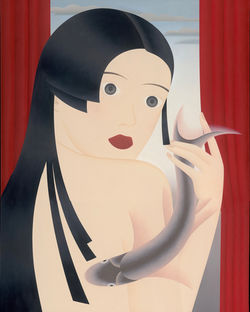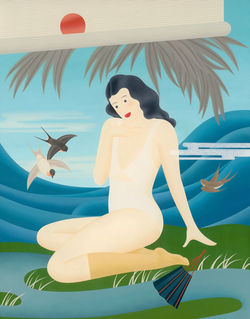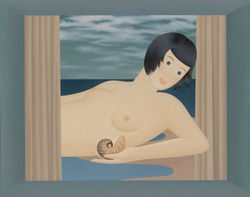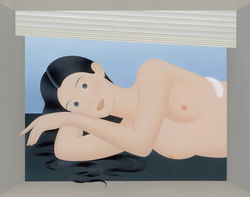In the representation of goddesses from various ancient civilizations, people naturally and instinctively admired certain qualities associated with femininity. In "The Great Mother: An Analysis of the Archetype," Erich Neumann draws upon the theories of his mentor, Swiss psychologist Carl Jung, to explore the depths of the "collective unconscious" of humanity, uncovering the archetypes that help us understand ourselves. The Great Mother of the Gods, a pivotal figure in the early development of self-awareness; transitioning from chaos to stability, initiated humanity's journey from focusing on themselves to comprehending the world. Some portrayals present her in a squatting stance, emphasizing full hips, while others depict her standing gracefully and slender. She can be the deity of the sky, symbolized by doves; or the queen of hell, symbolized by serpents. This goddess can be found within lofty mountains, lush forests, and vast oceans, seamlessly blending with the natural world; or surrounded by a multitude of animals, overseeing their entire spectrum of life. Like nature brimming with abundant vitality, she is worshipped, mythologized, and sculpted. Irrespective of how much we underscore the "unconscious" nature of symbolism, we cannot deny that symbols—particularly those that are clear and visible—are humanity's attempt to convey their experience of unity with nature through external images. These embodiments stand as the imprints of diverse human cultures.
However, much like all deities in the world, they are also subject to taboos, even both Pandora and Athena; Eve and the Virgin Mary. The source of life and the darkness of the abyss are associated with them, and Cybele, the Great Mother of the Gods, embodies precisely this duality. As the mother goddess of Phrygia, Cybele has always been worshipped with orgiastic rites, which have allowed her to cultivate a unique identity amid controversies. This exhibition takes its inspiration from this background and carries forward Liu Youran's established artistic trajectory. Through the delicate balance of contradictions, she seeks to portray female figures in her artwork as embodying both divinity and immanence, intricately weaving a dual nature between the physical and spiritual.
The debate over the shape of the female body within the context of art history has been a recurrent theme. However, Liu Youran's creative motivation stems from her desire to explore the potential for expressing female identities within the contemporary societal context. Here, she focuses more on the ways women are perceived and portray their real-life situations. Liu Youran inspires from the elements in ukiyo-e classics and the ambiance of traditional depictions of beauty into her artistic space by capturing the shared essence between the female body and the natural world, showcasing a distinctly personalized contemporary Eastern femininity aesthetic. Often, she shapes the figures in her artwork with a resemblance to puppets, revealing a relatively hollow and detached state. Through this nuanced stylistic approach, the scenario of the figures being observed, objectified, and alienated is accentuated within the artwork.
Liu Youran has consistently pursued the creation of visually pure and exquisite artwork. To distinguish herself from the traditional depictions of beauty from a male perspective, she intentionally incorporates elements of contrast within her compositions. In pieces like "Play 1:49 am" and "Model 6:45 pm," she smoothly blends human figures with a profusion of dynamic natural elements and animal imagery. By using subtly varied shades of blue and green, she generates visually compelling scenes bursting with vitality. The captivating power of a creative deity is unveiled within seemingly tranquil scenes but dramatic scenarios. However, this frozen moment resembles a still frame from a performance. The distorted spatial relationships and the sensation of post-production scene construction render the inherent passivity and immanence of these bodies beneath the self-evident divinity. The surrealistic painting language blurs temporal and spatial boundaries, defying the constraints of reality's logic. This adds fascination and an aura of mystery to the composition, while also crafting a more delicately nuanced metaphorical effect.
 Play,10-25pmOil and acrylic on canvas 200 x 160 cm 2022 |  Red,11-18pmOil and acrylic on canvas 140 x 110 cm 2023 |  Red,4-36amOil and acrylic on canvas 80 x 65 cm 2023 |
|---|---|---|
 Model 6-45 pmOil and acrylic on canvas 210 x 360 cm (210 x 120 cm x 3 ) 2023 |  Play,5-07amOil and acrylic on canvas 180 x 160 cm 2023 |  Play,1-49amOil and acrylic on canvas 200 x 160 cm 2022 |
 Peep,1-56amOil and acrylic on canvas 65 x 80 cm 2023 |  Peep,9-50amOil and acrylic on canvas 140 x 170 cm 2022 |  Outside the Window,9:21AMOil and acrylic on canvas 190 x 150 cm 2022 |
 Lying,11-56pmOil and acrylic on canvas 80 x 100 cm 2023 |  Model,8-20amOil and acrylic on canvas 140 x 110 cm 2023 |  Lying,10:29pmOil and acrylic on canvas 80 x 100 cm 2023 |
 Lying,0-30amOil and acrylic on canvas 80 x 100 cm 2023 |  Display,7-28amOil and acrylic on canvas 170 x 140 cm 2023 |  LetterOil and acrylic on canvas 200 x 150 cm 2023 |
 Box,WillowOil and acrylic on canvas 200 x 170 cm 2022 |  Box,DogOil and acrylic on canvas 170 x 200 cm 2022 |  Box,IrisOil and acrylic on canvas 200 x 170 cm 2022 |
 Box,Red RopeOil and acrylic on canvas 170 x 200 cm 2022 |
Artist

Liu Youran
b. 1996
Liu Youran graduated from the China Academy of Fine Arts with bachelor's and master's degrees. She now lives and works in Hangzhou, China.
Liu attempts to explore more possibilities for the expression of women's identity in the context of contemporary society, focusing on the women's viewing methods and realistic situations. Through the surrealist painting language, she presents the conflict between the basic requirements of women trying to establish themselves, the subject, and the requirements from the surrounding in a softer way.
Curator

Fiona Lu
Fiona Lu (b. 1992, Hubei, China), is the director of the exhibition department of Tang Contemporary Art. Her curating themes include intergenerational research of artists, gender research, fashion and virtual art, with special focus placed on the research of emerging art phenomena brought by young Chinese artists born in the 90s and 00s. Fiona is committed to bringing out the strength of younger generations of artists. Past curating works include: "Yue Minjun: Smile at the Flower Sermon” (2022), “Indoor Weather” Caochangdi spring art show (2022), "Memory, Playfulness, and Stream of Consciousness" (2022), “Global Song" (2022), “Low Fever" (2021), "Li Erpeng: Control" (2021), "Guo Yuheng Solo Exhibition" (2020), etc. She was also selected to be part of the Emerging Curator Project of Shanghai Museum of Contemporary Art (2018).



